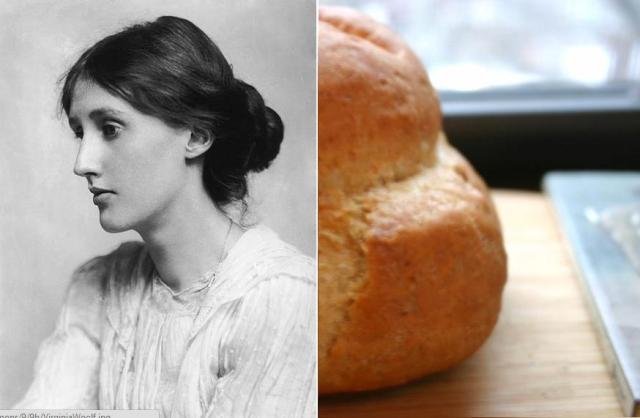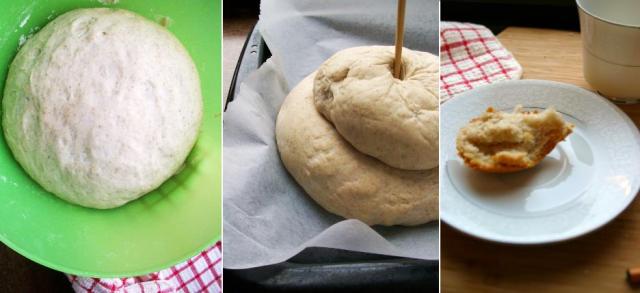Every time I get discouraged by writing, I engage in a bit of schadenfreude, and soothe myself with the frustrations of others. “I write two pages of arrant nonsense after straining … Then I trust to some inspiration on re-reading.” That’s Virginia Woolf while writing The Waves, but I’m pretty sure I said the same thing, more or less, while writing this post.
This constant self-effacement is a theme that runs through Woolf’s letters. Her talents didn’t really lie in the library, she would tell you. They were in the kitchen. “I have only one passion in life — cooking,” Woolf wrote to her friend (and occasional lover) Vita Sackville-West. “I have just bought a superb oil stove. I can cook anything … I assure you it is better than writing these more than idiotic books.”
Where Woolf hesitated to praise her own writing, she wasn’t nearly so shy about her talent for baking. “Cooked lunch today and made a loaf of really expert bread,” she wrote. Bread was her specialty, particularly a traditionally British double-decker creation: the snowmanesque cottage loaf. Her dedication to the kitchen was unusual for a woman of the upper-middle class. She did, however, draw the line at doing the dishes (“How servants preserve either sanity or sobriety if that is 9/10ths of their lives … God knows”).
In Recollections of Virginia Woolf, Louie Mayer, the Woolfs’ cook, marvels at Virginia’s calm expertise. “She showed me how to make the dough with the right quantities of yeast and flour, and then how to knead it. She returned three or four times during the morning to knead it again. Finally, she made the dough into the shape of a cottage loaf and baked it at just the right temperature.”
It’s Woolf’s birthday today; she would have been 131, although she didn’t make it even half that far, her mental illness wearing her away. But from Woolf’s letters, the time she spends cooking seems to be its own rest cure, clearing her head of everything else but the dough. “My bread bakes well,” she writes in her diary, and it resounds like a soothing mantra. If all else fails, I tell myself, my bread bakes well. My bread bakes well.
* * *
We don’t see many cottage loaves today. Even in the early 20th century, when Woolf was writing, they were going out of fashion. It’s believed they were originally shaped to save space in an oven — rising vertically instead of spreading out over the oven floor — but their unusual dimensions make them harder to cut or use for a sandwich.
But Woolf wasn’t the only literary champion of the cottage loaf. George Orwell, ever the expert about traditional English cooking, extolled its virtues as among the best food the U.K. had to offer, good just on its own. “If there is anything quite as good as the soft part of the crust from an English cottage loaf,” he wrote, “… I do not know of it.”
(Adapted from Bewitching Kitchen)
Preferment:
1 cup all-purpose flour
1 cup bread flour
1/2 teaspoon salt
1/2 teaspoon instant yeast
2/3 cup warm water
1. In a large bowl, sift together flours and salt. In a small bowl, dissolve yeast in water. Add to flour mixture and stir until dough forms. Let rest 10 minutes.
2. On a floured surface, knead dough briefly, then return to a greased bowl and allow to rise 1 hour at room temperature. Cover bowl with plastic wrap and refrigerate overnight.
Cottage loaf:
All of the preferment
1 teaspoon instant yeast
2/3 cup warm water
1 3/4 cups bread flour
1/4 cup rye flour
1/2 teaspoon salt
1. Remove the preferment from the refrigerator, cut into 8 wedges, and let sit 1 hour until it reaches room temperature.
2. In a small bowl, dissolve yeast in water. In a large bowl, mix together preferment, dissolved yeast, flours, and salt until a rough dough forms. On a floured surface, knead dough 10 to 15 minutes until smooth and elastic. Place in a greased bowl and let sit in a warm place 30 minutes, or until it has doubled in size.
3. Divide dough into 2 pieces (with 1/3 and 2/3 of the dough respectively) and form into tight balls. Place rounds on a greased baking sheet and set 10 minutes.
4. Preheat oven to 425°F. Place the smaller round on top of the larger round. Push a floured chopstick (or wooden spoon handle) completely through the center of the top round and 2/3 of the way into the bottom rounds to join them. Slash both rounds.
5. Bake 40 to 45 minutes, or until golden brown and loaf makes a hollow sound when tapped on the bottom.
Giveaway Update: A big hug and lots of chocolate to everyone who participated in the Paper and Salt birthday giveaway! I’m excited to announce that the winners are:
The New Yorker – Winnie
The Mid-Day Snacker – Meg Bowden
The Adventurer – Sara
Congratulations! I’ll be emailing/Facebook messaging you shortly so your books can find their new homes.



Thank for this. I absolutely adore Viriginia Woolf, I have a giant photo of her in my bedroom, and your selection of quotations is great!
Another lovely post. And I learned something. Cottage loaf! Who knew? Happy birthday, Virginia Woolf.
Oh, I love, love, love Virginia Woolf. Like Darya, I have a photo of her, but it hangs in my office, watching over me as I write. I like to imagine her banishing any angels of the house from the room while I work, shooing them away. While I’ve read most of her journals, I never knew the solace she took in cooking. More reasons to love her.
Lovely post. I feel soothed just by *reading*about Woolf’s cottage loaf.
I really enjoyed this post, especially her mantra “my bread bakes well.” Thanks for sharing this.
Thank you also for this–I never knew Virginia Woolf loved to cook! Lovely!
Pingback: Virginia Woolf: Cottage Loaf « indira ganesan
I took a Virginia Woolf seminar in college where we read all of her novels and many of her journals and letters. It was heaven! Thanks for bringing me back to that time.
Loved this blog. I remember visiting Monk’s Cottage.
I live in the Blue Mountains of NSW , where they say the air is so light you don’t need to add yeast to bread dough!
Pingback: Links: Citrus, Bread, and a Butter Softening Tip - Food in Jars | Food in Jars
Thanks for the link to BK, I had trouble stopping by as my work computer blocked access to this site for some strange reason… I am commenting from my iPhone sorry if typos abound. 😉
Thanks for this interesting article. I post a link on this facebook group page https://www.facebook.com/groups/universalbread/
Pingback: Links Galore « Annie Cardi
Pingback: Virginia Woolf: Cottage Loaf | Food, history and trivia | Scoop.it
Pingback: Virginia Woolf and other great literary cooks | WorldNews2GO
Pingback: Virginia Woolf and other great literary cooks | CooksChronicles.com
Pingback: Virginia Woolf: writer and bread baker « Blogging Woolf
Just found your blog. LOVE it! Thank you for being and sharing 🙂
Pingback: Samuel’s 2013 Great Baking Escapade Master List | Sex, Baking, Literature, Agony Aunt-ing…
what a great idea! love your blog and the concept. keep putting up these great posts! thanks.
Great blog! Follow you!
aliceinbo2.blogspot.com
Pingback: Episode 20: Virginia Woolf, Bread Therapy and Pretentious Ice Cubes « Alphabet Soup Podcast
I love your blog and I love Virginia Woolf. I’m not sure if I love the cottage loaf yet.
Pingback: Samuel’s 2013 Great Baking Escapade!: Virginia Woolf’s Cottage Loaf | Sex, Baking, Literature, Agony Aunt-ing…
Pingback: Virginia Woolf at the door (1913) | Bill Peschel
Pingback: The Woolfs’ personal library recreated online | Blogging Woolf
I heard somewhere that Virginia Woolf started cooking at age 40. Do you know if this is true?
Such an interesting idea for a post, never knew Woolf’s talents extended to bread making.
Beautiful post! Thank you so much for the link to my blog, appreciated it….
Of course – I love that recipe! Lots of people who have tried it here have all good things to say 🙂
Wondeful, thank you!
Pingback: Virginia Woolf’s Bread & Butter | feed.
Toutefois, il est recommandé de s’entraîner
dès 20 ans pour repousser l’apparition des premières rides.
magnificent issues altogether, you just won a emblem new reader.
What could you suggest about your put up that you just made a few days ago?
Any positive?
Brands, agencies, rights holders, teams,
leagues and other marketers worldwide can now measure, compare and leverage the impact of
celebrities both locally and globally.
Pingback: My Queer Kitchen #1: Our Daily Bread – Femme as in fuck you
Reblogged this on Eileen.
Pingback: Post #102: The Cottage Loaf | notes from the room in my head
It’s so interesting to me that she got out of her head and into her body/hands that often. I recently read a book saying we should all do as much when too much in our own thoughts. And I find it works as well as meditation, if not better . . . thanks for a great story.
Pingback: Virginia Woolf – – A SUMPTUOUS FEAST
Pingback: Virginia Woolf and the Complexities of Cottage Loaf - Gastro Obscura
Pingback: Eat it like Virginia Woolf - The Frontier Post 💥👩👩💥 - Latest News